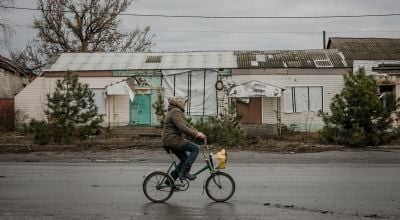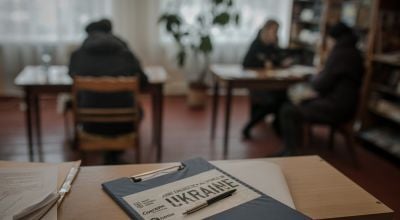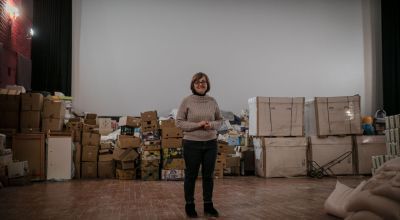
Read our 2023 annual report

Knowledge Hub
One year ago, a long-simmering crisis in eastern Ukraine escalated into an international conflict. Concern Worldwide began responding almost immediately, first to the influx of refugees entering Poland, Moldova, Hungary, Slovakia, and Romania, and — several weeks later — directly in Ukraine, where the need was greatest. As we mark one year of this conflict, we spoke with Charlie Acland, a member of Concern’s Surge Team who has spent much of the last year in Ukraine about what’s changed in the last year, and what needs to change in the year ahead.
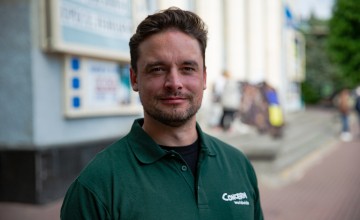
One year into this conflict, where are we at?
About 17 million people are currently displaced either inside or outside of Ukraine. We’ve seen destruction to infrastructure — especially in the east of the country.
I think the other major thing that’s happened as a result is that the economy’s contracted by about a third, and that’s exacerbated by the fact that a lot of people who have been displaced inside the country are struggling to find work. It’s just not out there. Prices have gone up as a result of conflict and availability. And throughout the winter, we’ve seen rising costs in energy prices; the thing people need to keep their houses warm.
So overall, the situation has become tougher for people. Living conditions have become tougher. At the same time, supply chains are still running, markets and shops are still open, the physical access to goods is there. I think what people really need support with now is in terms of being able to afford those items, and knowing how to access other services such as legal or psychological support.
In the first few weeks of this conflict, there was a strong story told in photos, videos, and other media: millions of people trying to get out of the country by any means necessary. One year later, are we still seeing that?
At the beginning of the conflict, there were obviously a lot of people trying to get out of the country, or trying to move to the west of the country. That slowed down considerably within a few months. But it is still there; it is still happening. Conflict is a dynamic thing. There are people who want to go home, and people have been able to go home. Other people have wanted to go home, even if it was dangerous, because they wanted to check on their home, on senior family members… people have moved back and forth.
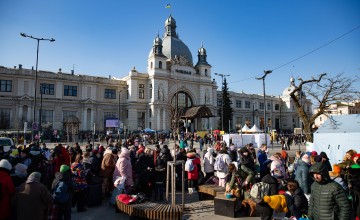
Through the spring, summer, and early autumn of 2022, people had gotten into a bit of a rhythm. There were still needs there, but people had power, prices were what they were. Then power and energy started becoming an issue for people as well. And that really increased the level of need, especially for the most vulnerable people living here. We have buildings that were damaged or never completed with the cold setting in; people are unable to heat their homes. So that was a whole new layer of vulnerability, much worse than we perhaps anticipated. We knew it would be a struggle, but we didn’t think it would get that bad. That’s where we are now.
Why did it get worse than we anticipated?
Power, energy — it’s purely down to that. And the authorities have been incredibly responsive to that. In particular, they’ve done a great job of setting up these Invincibility Centres, for instance, where people can go and get warm, or charge their mobile phones, whatever they need to do. And that quite characterises the Ukrainian response to this conflict: very community-led, making sure that things are actually moving. It’s a characteristic of people who face a lot of awful things. They lose a lot, they’re dealing with traumatic experiences, but they do find a way to make it work. That’s where the hope lies.
"They lose a lot, they’re dealing with traumatic experiences, but they do find a way to make it work. That’s where the hope lies."
One thing we’ve seen at Concern in other conflict responses is the importance, too, of psychological support for children.
I think that’s true for everybody, not just children. There’s a lot of people who have gone through some extremely harrowing experiences. Many don’t know where to access services to address those experiences. So we provide a lot of help in terms of mapping out where those services lie. We have local partners like Posmishka and Light of Hope providing mobile psychosocial support teams. They’ll go into villages to make sure that people have access to group therapy sessions and individual therapy sessions.
We also set up child-friendly spaces so that the children can go and just be comfortable in their new location. There are ways of helping them work through things that they don’t necessarily understand: what’s happened, why these things are happening. We always look at the material needs of people, but the psychological impact of a conflict like this is huge, and you have to make sure you’re guiding the future of peoples’ well-being.
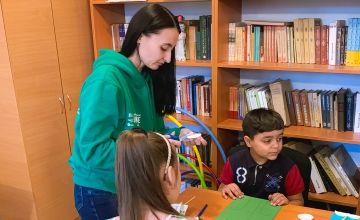
What are some of the long-term challenges we’re facing right now in Ukraine?
I think a lot of it is around the uncertainty of the situation. We don’t know how this conflict is going to end, which could affect the type of support we provide. We’ve been providing financial support, we’ve reached over 15,000 people with cash assistance to make sure they can buy the items they need. But how long does that continue?
People’s businesses have closed down, infrastructure has been damaged, homes have been damaged, at some point we need to start thinking about: How do we help people not just to survive, but to recover and to grow? That would be the next stage, and what we’ve got to start working towards. But a lot of it relies on what happens.
Concern has been working in Ukraine for the better part of the last year, but working here means having to deal with the same situations as Ukrainian civilians.
There’s two sides to it. Coming back to the topic of energy, when that goes, communications goes, electricity goes, people’s ability to work goes. You do have to go down to a bunker during the air raid sirens, and that does stop you from being able to do your work. Sometimes the alarms can go for several hours a day, or at any time of the day. I can’t really quantify what it does, but a lot of it comes down to us making sure we’re planning in advance for the things that we know we’ve got coming in, and what we’re going to be providing people.
We’re also very fortunate to have some excellent national partners who have been going out and getting on with their work. In terms of registering people to receive cash assistance, in terms of managing these mobile teams, we wouldn’t be able to do any of this without them. They face the same challenges, but luckily we’re able to work as a team to help things to go through.
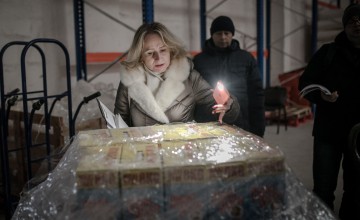
Does the fact that we can do so much remotely or via mobile and digital technology help when movement is restricted?
Certainly for cash transfers. The way that works, people will get either a monthly transfer of about €65 a month for three months, or they get a one-off grant to buy winter clothes or support to pay for heating over the winter. And that’s all done via money transfers and SMS. And that’s fantastic. But, again, it’s one of those risks: If the situation worsens and communications networks are down, it’s much harder for people to receive that money. So we always have to be aware of that risk, and we always have to be ready to adapt. We always make sure we have stocks of physical items available. We make sure we have contingencies. We always have to think of these scenarios: What if, what if, what if?
You’ve been here for most of the last year. Are there any moments that have especially stuck out for you?
The capacity of Ukrainians to organise themselves. We’ve been working through humanitarian hubs in the areas where we work, which are usually housed in universities, one’s in a cinema, for instance. And they’re run by local communities and are helping people have a central location where they can come and get information on services, where they can get supplies, where they can get a meal. Our plan is eventually to work with super-local community groups on the distribution of basic items in locations that are difficult to access, because those groups are already there.
That’s become a point of debate, both in Ukraine and elsewhere, about international NGOs responding to crises where there are already local organisations that do the same work and know the specifics of their communities.
I think this is a very effective way of working. We’re able to leverage local knowledge of how things work, access to locations we wouldn’t otherwise be able to get to, and it means it’s a much more locally-driven response. It means that it’s much more aligned with people’s needs. And it means that they’re more likely to own what happens, which is great.
What we and other international NGOs can bring to the table is a large amount of resources. We can help local organisations to reach people at scale. Our local partners often struggle to access international donor funding, and we can help with that either through training or helping them with the bureaucratic challenges that come with funding. We’ve organised trainings on psychosocial first aid for our mobile teams. We’ve been supporting them in setting up complaint and response mechanisms, so that we can be held accountable and more effective, and so that people can say what’s working for them and what’s not.
Concern also isn’t doing this alone. We have this joint program with our Alliance2015 partners, Welthungerhilfe and Cesvi, the Joint Emergency Response in Ukraine (JERU). We’re all working together with local partners like Light of Hope and Posmishka.
What are some of the advantages to that?
The same things, really. We’ve got a huge amount of context knowledge, technical capacity, financial resources, and staffing, without duplicating the costs of five NGOs working separately. It means we can reach more people.

Last year the Joint Emergency Response in Ukraine reached nearly 50,000 people — double the number we initially expected to reach. What are some of the goals for the year ahead?
Part of it is to continue ensuring the most vulnerable people have access to the same services that they need, and that we’re doing it in a way that is in tune with what they’re telling us. And also, depending on how things play out, we also have to start looking at what comes next with people. We know in some of the locations where we work, such as Sumi Oblast, there are people who would very much like to restart their businesses. It’s just a case of getting access to the support they need to make that happen.
In a lot of cases, people have moved and they don’t want to move home, or they can’t move home for very good reason. So how do we make sure they can integrate into their host community? How do we help them restart their livelihoods while helping Ukraine to recover? I think we need to start looking in that direction, conditions allowing.
Psychological support also remains really important. We need to make sure that people have an understanding of how they can get that support, that it’s okay to get that support, and that they know they can trust in the service. Quite often, people who have been through a hell of a lot don’t really know how to get help, and I think that’s something we shouldn’t forget.


